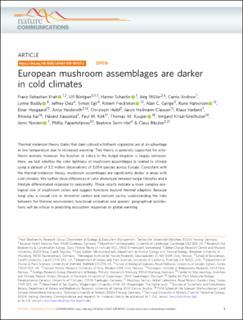| dc.contributor.author | Krah, Franz-Sebastian | |
| dc.contributor.author | Büntgen, Ulf | |
| dc.contributor.author | Schaefer, Hanno | |
| dc.contributor.author | Müller, Jörg | |
| dc.contributor.author | Andrew, Carrie | |
| dc.contributor.author | Boddy, Lynne | |
| dc.contributor.author | Diez, Jeffrey | |
| dc.contributor.author | Egli, Simon | |
| dc.contributor.author | Freckleton, Robert | |
| dc.contributor.author | Gange, Alan C. | |
| dc.contributor.author | Halvorsen, Rune | |
| dc.contributor.author | Heegaard, Einar | |
| dc.contributor.author | Heideroth, Antje | |
| dc.contributor.author | Heibl, Christoph | |
| dc.contributor.author | Heilmann-Clausen, Jacob | |
| dc.contributor.author | Høiland, Klaus | |
| dc.contributor.author | Kar, Ritwika | |
| dc.contributor.author | Kauserud, Håvard | |
| dc.contributor.author | Kirk, Paul M. | |
| dc.contributor.author | Kuyper, Thomas W. | |
| dc.contributor.author | Krisai-Greilhuber, Irmgard | |
| dc.contributor.author | Nordén, Jenni | |
| dc.contributor.author | Papastefanou, Phillip | |
| dc.contributor.author | Senn-Irlet, Beatrice | |
| dc.contributor.author | Bässler, Claus | |
| dc.date.accessioned | 2020-03-20T11:21:01Z | |
| dc.date.available | 2020-03-20T11:21:01Z | |
| dc.date.created | 2019-07-01T09:41:43Z | |
| dc.date.issued | 2019-10-10 | |
| dc.identifier.citation | Nature Communications. 2019, 10:2890 1-11. | en_US |
| dc.identifier.issn | 2041-1723 | |
| dc.identifier.uri | https://hdl.handle.net/11250/2647803 | |
| dc.description.abstract | Thermal melanism theory states that dark-colored ectotherm organisms are at an advantage at low temperature due to increased warming. This theory is generally supported for ectotherm animals, however, the function of colors in the fungal kingdom is largely unknown. Here, we test whether the color lightness of mushroom assemblages is related to climate using a dataset of 3.2 million observations of 3,054 species across Europe. Consistent with the thermal melanism theory, mushroom assemblages are significantly darker in areas with cold climates. We further show differences in color phenotype between fungal lifestyles and a lifestyle differentiated response to seasonality. These results indicate a more complex ecological role of mushroom colors and suggest functions beyond thermal adaption. Because fungi play a crucial role in terrestrial carbon and nutrient cycles, understanding the links between the thermal environment, functional coloration and species’ geographical distributions will be critical in predicting ecosystem responses to global warming. | en_US |
| dc.language.iso | eng | en_US |
| dc.relation.uri | http://hdl.handle.net/11250/2603029 | |
| dc.rights | Navngivelse 4.0 Internasjonal | * |
| dc.rights.uri | http://creativecommons.org/licenses/by/4.0/deed.no | * |
| dc.subject | perman | en_US |
| dc.title | European mushroom assemblages are darker in cold climates | en_US |
| dc.type | Peer reviewed | en_US |
| dc.type | Journal article | en_US |
| dc.description.version | publishedVersion | en_US |
| dc.rights.holder | © The Author(s) 2019 | en_US |
| dc.subject.nsi | VDP::Zoologiske og botaniske fag: 480 | en_US |
| dc.subject.nsi | VDP::Zoology and botany: 480 | en_US |
| dc.source.pagenumber | 1-11 | en_US |
| dc.source.volume | 10:2890 | en_US |
| dc.source.journal | Nature Communications | en_US |
| dc.identifier.doi | 10.1038/s41467-019-10767-z | |
| dc.identifier.cristin | 1708940 | |
| dc.relation.project | Andre: SWISS NATIONAL SCIENCE FOUNDATION | en_US |
| dc.relation.project | Andre: Swiss National Science Foundation | en_US |
| dc.relation.project | Norges forskningsråd: 225043 | en_US |
| cristin.ispublished | true | |
| cristin.fulltext | original | |
| cristin.qualitycode | 2 | |

